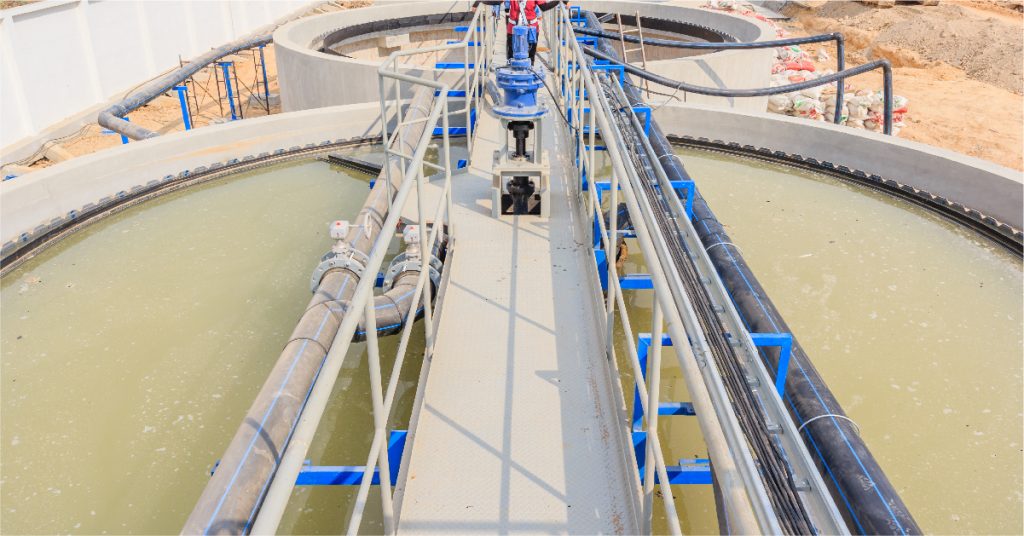Effective water treatment is essential for both industrial and municipal applications to ensure clean, safe, and reusable water. One of the most vital components in this process is the clarifier. A clarifier in water treatment plays a crucial role in removing solids and reducing turbidity, making water suitable for further purification or discharge. Understanding the purpose and process of clarifiers can help facilities make informed decisions about water treatment infrastructure, ensuring operational efficiency and regulatory compliance.
Table of Contents
Toggle- What is a Clarifier in Water Treatment?
- Purpose of a Clarifier in Water Treatment
- Types of Clarifiers in Water Treatment
- How a Clarifier Tank in Water Treatment Works?
- Applications of Waste Water Treatment Clarifiers
- Benefits of Using a Water Treatment Clarifier System
- Ion Exchange Delivers Advanced Wastewater Treatment Solution for Industries
- Conclusion
What is a Clarifier in Water Treatment?
A clarifier is a large, circular or rectangular tank used in the water and wastewater treatment process. Its primary function is to allow suspended solids to settle at the bottom due to gravity. The cleaner water, or effluent, overflows from the top, while the settled solids, called sludge, are collected at the base. This process is typically one of the first steps in a comprehensive water treatment clarifier system and is essential for reducing the load on downstream processes like filtration and disinfection.
Purpose of a Clarifier in Water Treatment
The main purpose of a clarifier water treatment system is to separate solid particulates from water or wastewater. This significantly improves water quality and prepares it for secondary treatment stages. Clarifiers also help reduce chemical consumption and energy use in later processes, making them a cost-effective and sustainable solution for large-scale water treatment operations.
In industrial applications, clarifier tanks in water treatment are used to pre-treat process water or to treat effluent before discharge. In municipal systems, clarifiers help manage large volumes of sewage or stormwater, reducing the burden on biological treatment units and ensuring smoother operation of the overall system.
Types of Clarifiers in Water Treatment
There are several types of clarifiers, each suited for specific applications and water characteristics:
- Primary Clarifier in Water Treatment
A primary clarifier is used in the early stages of the wastewater treatment process. It removes settleable organic and inorganic solids by sedimentation, and floating materials like oil and grease are skimmed off. This step is essential in preparing wastewater for biological treatment, as it reduces the organic load and helps maintain the health of downstream microbial systems. - Secondary Clarifier
Found after the biological treatment process, secondary clarifiers are designed to remove biomass or biological solids formed during aeration. These clarifiers help separate treated water from the microbial floc, ensuring high-quality effluent. - Lamella or Inclined Plate Clarifiers
These compact clarifiers are ideal for space-constrained sites. They use a series of inclined plates to increase settling area and efficiency, making them useful in industrial or small municipal applications.
How a Clarifier Tank in Water Treatment Works?
The working principle of a clarifier tank in water treatment is based on gravity settling. The influent enters the tank and flows at a controlled rate, allowing heavier particles to settle at the bottom. Some clarifiers are equipped with mechanical scrapers or rakes to move the settled sludge toward a central hopper for removal. Meanwhile, lighter particles or floatables rise to the surface and are removed using skimmers.
Applications of Waste Water Treatment Clarifiers
Waste water treatment clarifiers are used across various sectors, including:
- Municipal wastewater treatment plants where large volumes of domestic sewage.
- Industrial facilities, such as food and beverage, pharmaceuticals, chemicals, and textiles, which generate high-load effluents requiring effective solids removal.
- Power plants and refineries, where water recycling and discharge compliance are critical.
- Construction and mining operations, where sediment control is a major challenge.
Benefits of Using a Water Treatment Clarifier System
- Efficient Solid-Liquid Separation:
Clarifiers remove up to 60% of suspended solids and up to 30% of biochemical oxygen demand (BOD) in the primary stage, making downstream processes more efficient. - Reduced Chemical Usage:
By removing a significant portion of contaminants early, clarifiers reduce the need for chemicals in subsequent treatment stages. - Energy and Cost Savings:
Lower turbidity and solids in water reduce strain on pumps, filters, and biological units, translating to lower energy use and maintenance costs. - Improved Water Quality:
A water treatment clarifier system enhances the clarity and quality of treated water, making it safer for reuse or discharge. - Environmental Compliance:
Waste water treatment clarifiers help meet discharge standards by significantly reducing suspended solids and other pollutants.
Ion Exchange Delivers Advanced Wastewater Treatment Solution for Industries
Ion Exchange is enabling sustainable operations at Chiripal Poly Films, one of India’s leading manufacturers of flexible packaging solutions and a part of the Chiripal Group conglomerate. Specializing in Biaxially-Oriented Polypropylene (BOPP) films, Biaxially-Oriented Polyethylene Terephthalate (BOPET) films, and PET resin chips, Chiripal’s manufacturing process uses Mono-Ethylene Glycol (MEG) and Ethyl Acetate (EA), resulting in effluents with high toxicity and elevated BOD and COD levels.
To treat this complex chemical wastewater, Ion Exchange is supplying a 200 m³/day Effluent Treatment Plant (ETP) featuring primary, secondary, and tertiary treatment systems. The primary stage includes a bar screen, oil skimmer, equalisation-cum-neutralisation tank, and guard pond; the secondary stage consists of an anaerobic process, clarification, and an extended aeration system. The tertiary treatment involves a chlorine contact tank and a sludge treatment system, enabling the recycling and reuse of treated water for process and utility applications, thereby supporting Chiripal Poly Films’ sustainability goals.
Conclusion
A clarifier in water treatment is a foundational component that ensures the efficiency, sustainability, and compliance of the entire water treatment process. From municipal sewage treatment to complex industrial wastewater systems, clarifiers play a key role in removing suspended solids, reducing pollutant loads, and preparing water for further treatment or discharge.







